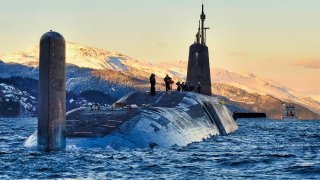Not in the U.S. Navy: Vanguard-Class Submarines Have 1 Job Only
The Royal Navy's Vanguard-class nuclear submarines serve as the UK's strategic nuclear deterrent, carrying Trident II D5 missiles. Introduced in 1994, the four Vanguard-class subs are the largest built in the UK and the third-largest vessels in the Royal Navy.
Summary and Key Points: The Royal Navy's Vanguard-class nuclear submarines serve as the UK's strategic nuclear deterrent, carrying Trident II D5 missiles. Introduced in 1994, the four Vanguard-class subs are the largest built in the UK and the third-largest vessels in the Royal Navy. Their only mission is to fire a vast amount of nuclear weapons at any targets - if ever called upon to do so.

-These subs will eventually be replaced by the Dreadnought-class.
-The Vanguard-class also features advanced sonar systems and torpedoes for anti-submarine and anti-surface warfare. Despite aging, they remain crucial to the UK's defense strategy.
Vanguard-Class Submarines: UK's Nuclear Deterrent Powerhouses
The Royal Navy’s four Vanguard-class nuclear-powered submarines (SSBNs) currently form the UK’s strategic nuclear deterrent force. Each of the boats is armed with Trident II D5 nuclear missiles. They are also the largest submarines ever constructed in the UK and are the third-largest type of vessel in the Royal Navy.
The Vanguard-class was introduced in 1994 as part of the British military’s Trident nuclear program and includes just four boats: Vanguard (S28), Victorious (S29), Vigilant (S30), and Vengeance (S31). The submarines were constructed between 1986 and 1999 at Barrow-in-Furness, Cumbria by the former Vickers Shipbuilding and Engineering (now BAE Systems Marine).
All four of the submarines are based at HM Naval Base Clyde, west of Glasgow, Scotland. The Vanguard-class boats were originally intended for a service life of twenty-five years, and will be replaced as the new Dreadnaught-class of ballistic missile submarines is set to enter service.

Each submarine is powered by a Rolls-Royce PWR2 nuclear reactor, with two GEC turbines; and has a single shaft and a single pump-jet propulsor and two WH Allen turbo generators.
Vanguard-Class: Largest Subs in the Royal Navy
At nearly 150 meters in length and more than 16,000 metric tons, the Vanguard-class remains the largest submarine type ever constructed in the UK, and it has remained the third-largest type of combat vessel in service with Royal Navy. The submarines have twice the displacement of the Polaris submarines of the Resolution-class. Due to the size of the boats, a special production facility had to be built to handle the construction of the Vanguard and her sister submarines.
The increased size of the subs was necessary to accommodate the Trident D5 missile, yet the complement of the class is small at just 132 officers and sailors, compared to the Polaris boats, which required a crew of 149. The 16-tube missile compartment on the new Trident submarines is based on the 24-tube system utilized on the United States Navy’s Ohio-class Trident submarines. Missile maintenance occurs in the United States, while the UK Atomic Weapons Establishment at Aldermaston was responsible for all the design, construction and installation, as well as maintenance of the warheads.
The Trident nuclear missiles can be fired at targets up to 4,000 miles away and at their maximum speed travels at more than 13,000 miles an hour.
The Vanguard-class was also designed with several significant improvements, which included a new design of the nuclear propulsion system as well as a new tactical weapon system or self-defense purposes, both before and after a missile launch. Under “normal” conditions, the submarines are equipped with one to three warheads depending on mission, yet each Vanguard-class submarine is capable of carrying 192 warheads.
In September 2009, British Prime Minister Gordon Brown told the UN General Assembly that the UK was ready to reduce its Vanguard-class submarine force by one. Brown had said that the offer was being made to encourage other nuclear-powered countries to move towards a nuclear-weapons-free world. However, such a move never came to pass.
Missiles and Torpedoes
While designed to serve as a nuclear deterrent, the Vanguard-class boats are also equipped with four 21-inch (533mm) torpedo tubes and can carry up to 16 Spearfish heavyweight torpedoes, which can be guided by copper wire or by autonomous active or pass sonar.
At full speed, the Spearfish can attack a target up to 14 miles away, while at low speed the range is increased to more than 30 miles. The torpedoes can deliver a 660 pound explosive charge, and that provides the boats with both anti-submarine (ASW) and anti-surface warfare (ASuW) capabilities.
The boats are also fitted with what the Royal Navy calls “world-beating sonar,” which is reportedly so sensitive that it can “hear” vessels more than 50 miles away. That can help ensure that the Vanguard-class can live up to its moniker and remain the foremost part of an advancing naval force.
About the Author
Peter Suciu is a Michigan-based writer who has contributed to more than four dozen magazines, newspapers and websites. He regularly writes about military hardware, and is the author of several books on military headgear including A Gallery of Military Headdress, which is available on Amazon.com. Peter is also a Contributing Writer for Forbes.
All images are Creative Commons.


